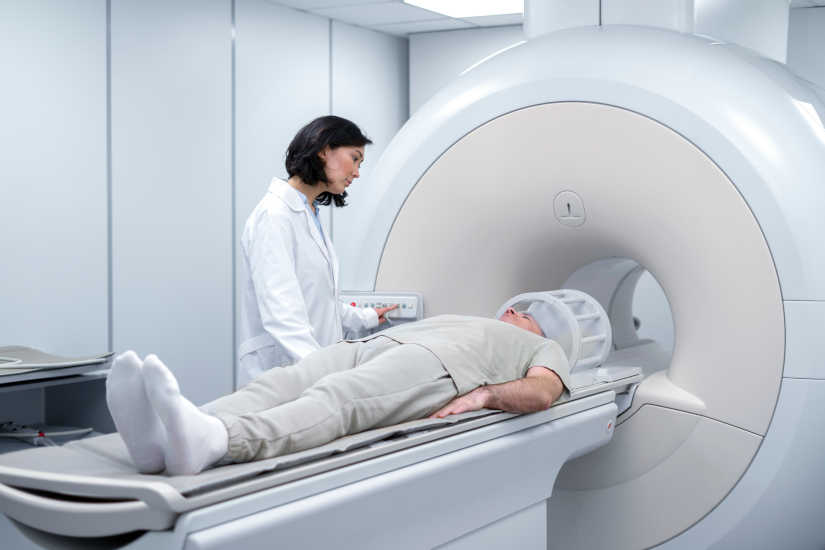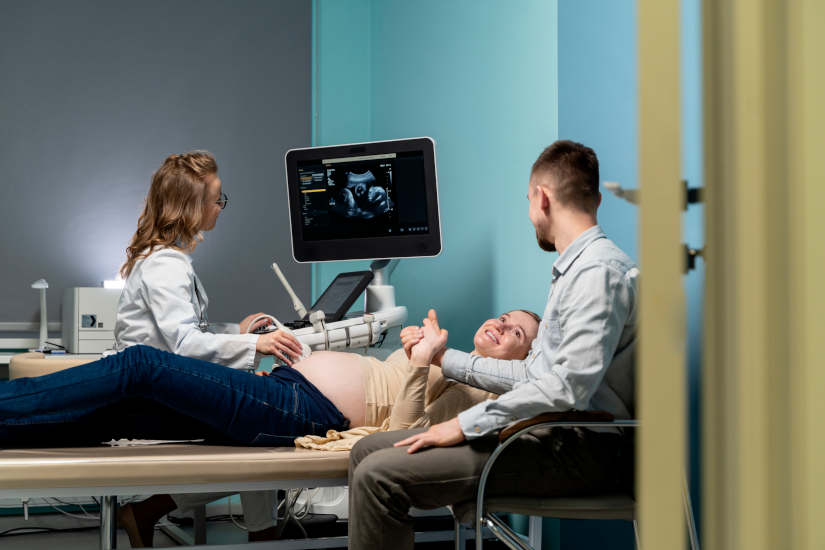
Magnetic Resonance Imaging: What it is and what it can detect
The magnetic resonance imagingalso known by its acronym IRM, is a non-invasive diagnostic imaging technique which produces three-dimensional anatomical images. The MRI uses powerful magnets and radiofrequency waves which allow the creation of detailed images of the organs, tissues and internal structures of the body. Unlike other methods such as radiography or computed axial tomography (CT), magnetic resonance imaging (MRI) can be used to create detailed images of organs, tissues and structures inside the body. does not use ionizing radiation or X-raysIt is a safe, painless medical test that does not cause any harm to the patient.
This is one of the most widely used techniques for the production of medical diagnostics, analyze the different tissues and check for any disease, injury or abnormality.. MRI is used by health professionals to examine certain parts of the body and to study the differences existing between healthy and unhealthy tissuesas well as tissues that present abnormal conditions. MRI allows the creation of detailed three-dimensional images to examine organs such as the brain, spine, joints such as the knee, shoulder, hip, wrist and ankle; the abdomen, pelvic region, breasts, blood vessels and heart, among other regions.
To perform a MRI examinationis used, a magnetic resonance medical equipment. In this procedure, the patient is placed inside an MRI scanner. We can define it as a large circular apparatus which is open at both ends. Once the patient is inside the MRI equipment, a series of signals and radio waves are produced and detected by a receiver inside the device. Subsequently, the cross-sectional images of tissues that are visualized through a computer.
What is this process like and what does MRI detect? In the following article, we explain the origin of this medical technique and how it works, as well as its advantages and limitations.
Origin of magnetic resonance imaging
In 1946, Felix Bloch and Edward Purcell independently discovered the magnetic resonance phenomenonfor which they were awarded the Nobel Prize in Physics in 1952. But, actually, its development as a chemical and physical molecular analysis procedure took place in the period between 1950 and 1970. Beginning in 1971, Raymond Damadian demonstrated that MRI relaxation times differed between healthy and tumor tissues, which led scientists to begin to study this technique for the diagnosis of diseases.
At the same time, in 1973 Hounsfield introduced another of today's most widely used medical techniques: computed tomography (CT), which uses X-rays. The success of TAC The results showed that hospitals were willing to invest in the development of new diagnostic imaging equipment, which also drove the development of MRI. In the same year, Paul Lauterbur obtained the first magnetic resonance image, using a back projection technique similar to that of computed axial tomography.
As of 1980sthe gradual implementation of MRI in clinical practiceto the current situation. Today, magnetic resonance imaging is one of the most widely used diagnostic imaging techniques.
How does MRI work?
The human body is composed mainly of water and fat, so that hydrogen atoms account for 63% of the total number of atoms in the body. The hydrogen nucleuswhich consists of a proton, is used in magnetic resonance imaging because it acts like a powerful magnet that generates a magnetic field around the patient's body. MRI is a diagnostic imaging method based on the absorption and emission of energy in the form of a set of radiofrequency signals within the electromagnetic radiation spectrum. The radiofrequency used in MRI produces frequencies of between 15 and 80 megahertz, making it a non-ionizing radiation that is harmless to the body.
In an MRI exam, the patient is placed inside an MRI scanner. magnetic resonance scanner which produces radio waves that interact with the protons, generating a series of radio frequency signals that are detected by a receiver inside the device. All these signals emitted and detected by the scanner's antenna are processed in a computer, where they are detailed images of the fabrics and inside the organism that allow the medical diagnosis to be made.
Specifically, a MRI equipment consists of the following elements:
- External magnet
- Magnetic field gradients
- Radio frequency transmitter
- Radio frequency receiving antennas
- Computer
How is an MRI exam performed?
To perform an MRI exam, a medical MRI machine is used, where the patient is introduced into a large device that has a circular shape and is open at the ends. This procedure is performed in a special room housing the MRI system or scanner. A member of the MRI staff accompanies the patient into the room, where he/she will be asked to lie down on a padded table and then be introduced into the machine to begin the MRI diagnosis.
Before the test
The majority of diagnoses have a duration between 15 and 45 minutesdepending on the part of the body to be tested and the number of images needed. Before the test, the person must partially or completely undress and is provided with a gown that has no buttons or metal fasteners. It is important to leave all metal objects and other items that could be affected by the magnetic field outside the MRI room. For example, keys, jewelry, cell phones, credit cards or watches.
During the test
It is important that the patient remains still and relaxed.. In some examinations, an intravenous injection of a contrast material called gadolinium to obtain a clearer image of the area to be examined. To do this, at the beginning of the medical test, a nurse will place an intravenous line into a vein in the patient's arm or hand using a small needle.
On the other hand, it should be noted that the magnetic resonance system can produce certain loud noises during the procedure. To prevent any problems associated with noise, earplugs are provided. For the duration of the diagnosis, the patient will be monitored at all times and will be able to communicate with a medical professional via an intercom.
After the test
Once you have completed the exam, images will be reviewed by a radiologistwho will subsequently inform the physician of the results of the MRI examination.
MRI in medical practice
Magnetic resonance imaging is a procedure used to study the differences that exist between healthy and unhealthy tissues, as well as other regions of the human body that present abnormal conditions. Nowadays, it is one of the most widely used diagnostic imaging techniques and it allows for detect a large number of diseases and abnormalities in virtually all regions of the body:
- HeadCentral nervous system, orbit, face and skull.
- Neck.
- SpineSpinal cord, meninges, bone spine and intervertebral discs.
- Chestespecially at the cardiovascular level.
- Abdomenliver, biliary tract, spleen, pancreas, urinary tract, genital tract and pelvis.
- Large joints and extremities.
What does MRI detect?
MRI is often prioritized over CT scanning when the physician needs to have more detail about the soft tissues. For example, it helps to obtain images of abnormalities in the brain, spinal cord, muscles and liver. It is also very useful in identifying tumors in these tissues. MRI has the following clinical applications:
- Morphological applicationsDefinition of congenital anomalies, traumatic pathology, detection and extension of tumors,
degenerative diseases, vascular pathology, inflammatory processes and infectious pathology. - Functional applicationsThese are functional brain MRI studies and functional cardiac studies.
- Tissue analysis applicationsMRI spectroscopy, chemical shift studies, perfusion studies and diffusion studies.
This diagnostic technique is also used to analyze other types of conditions and as an alternative to other procedures that present greater risks:
- Measuring the presence of certain molecules in the brain that distinguish a tumor from an abscess.
- Identify alterations in the female genitalia and fractures in the hip and pelvis.
- Perform the valuation of certain common joint anomaliessuch as torn knee ligaments or cartilage and sprains.
- Study and evaluate bleeding and other infections.
- MRI is applied when the The risks of performing a CT scan are high.. Especially, it can be used in people who have had a reaction to iodinated contrast media in a CT scan and for pregnant women, because radiation can cause problems in the fetus.
Types of magnetic resonance imaging
We can distinguish between different types of MRI:
Functional Magnetic Resonance Imaging or fMRI
fMRI is used for observe the structures and functioning of the brain. It measures the small changes in blood flow that occur in brain activity. This type of test helps detect abnormalities within the brain that cannot be found with other imaging techniques.
Perfusion magnetic resonance imaging
Professionals can use this type of magnetic resonance imaging for to estimate the blood flow in a particular area. It is useful in determining whether the blood supply to the brain has been reduced when a stroke. It also serves to identify areas where blood flow is increased, such as in the case of the tumors.
Diffusion-weighted magnetic resonance imaging
It is used to detect changes in the water movements of cells that are not functioning normally. It helps to identifying early stages of strokes, detect brain disordersanalyze whether a tumor has spread o differentiate a brain abscess from a tumor.
Magnetic resonance spectroscopy
This type of test is used for detect brain disordersThe method can distinguish between dead tissue within an abscess and the presence of multiplying cells within a tumor. Specifically, this method can distinguish between dead tissue within an abscess and the presence of multiplying cells within a tumor. In turn, it is used to to assess metabolic disorders of the muscles and nervous system.
Magnetic resonance angiography
Provides detailed images of blood vesselsIt is used to assess the blood vessels of the brain, heart, abdominal organs, arms and legs. In particular, this technique is used to analyze aortic aneurysms, aortic dissection, narrowing of the arteries of the extremities, thrombi in the veins of the extremities, blood flow to tumors and tumors affecting the blood vessels.
Magnetic resonance venography
This is a magnetic resonance imaging of veins. Detects the cerebral venous thrombosisThe presence of thrombi in a vein that carries blood from the brain.
Advantages of magnetic resonance imaging
MRI has established itself as a safe, accurate and effective diagnostic imaging method. Currently, MRI stands out for offering many advantages, which has led to the prioritization of this technique over other procedures, especially computed tomography, radiological tests and ultrasoundsWhat are the advantages?
- It is a non-invasive, safe and painless scanning technique. It does not use ionizing radiation or nephrotoxic contrast media and does not produce adverse effects in patients.
- MRI is a test that helps to assess both the structure of an organ and its functioning.
- Provides a high spatial, temporal and tissue resolution for tissue differentiationTherefore, MRI has an important role in the early diagnosis of soft tissue diseases.
- It has three-dimensional capabilityThe system provides detailed, cross-sectional images of the tissues and organs to be examined. In this way, it makes it possible to detect anomalies that could be hidden by the bones when other diagnostic methods are used.
- Allows you to to perform functional studies. Functional Magnetic Resonance Imaging or fMRI is a medical test used to examine the parts of the brain that are handling critical functions, evaluate the effects of stroke or other diseases, as well as guide brain treatment.
Limitations and risks of magnetic resonance imaging
However, it also presents some risks and disadvantages that are important to analyze:
Increased diagnostic time and cost
The time required to perform an MRI scan is high. For this reason, CT is often used in emergency situations, such as severe injuries and strokes. In turn, the economic cost is higher and there is a limitation in availability compared to other imaging techniques.
Anxiety and claustrophobia problems
The magnetic resonance equipment is a small, enclosed spaceThe patient may feel a feeling of claustrophobia or anxiety. For this purpose, the patient may be given an anxiolytic, such as alprazolam or lorazepam, prior to the start of the examination.
Currently, there are also open magnetic resonance scannerswhich offer an open side and a wider interior. This makes people can reduce claustrophobia and obese people can access more easily. However, the images produced may be of lower quality. But despite this, such open devices can be used for diagnostics.
Magnetic field effects
The presence of implanted metallic devices or materials in the patient's body can produce certain adverse effects. The magnetic field used in this medical technique is very powerful and always active, which can cause the devices to shift, overheat or malfunction. In addition, they can also distort the images generated.
Among these devices are the cardiac pacemakers, defibrillators, cochlear implants and metallic magnetic clicks used in the treatment of aneurysms. However, other devices such as dental implants, hip replacements or spinal straightening rods have none of these effects. Therefore, it is important that people who have any implanted devices inform the physician before making an IMR diagnosis.
Reactions to contrast agent
The gadolinium contrast media can lead to a number of reactionsThe most common symptoms are headache, nausea, pain and cold sensation in the area where the injection is made, distortion of taste and dizziness. However, it should be pointed out that these contrast agents present lesser reactions than iodinated contrast media used in CT scans and CT angiography.
In conclusion, magnetic resonance imaging is a diagnostic imaging technique that provides detailed, cross-sectional imaging examinations that are essential in the detection of disease and for studying virtually all regions of the human body.
Bibliography
Data Analysis Research Group of the University of Seville (2004). Basic principles of nuclear magnetic resonance. Annals of the Royal National Academy of Pharmacy, 70(1), 59-72. Retrieved from https://analesranf.com/wp-content/uploads/2004/70_01/7001_03.pdf
Gili, F. (n.d.). Nuclear magnetic resonance in small animals. Vet Communications. Retrieved from https://vetcomunicaciones.com.ar/uploadsarchivos/libro.gili.pdf
De la Fuente, A., & Gutiérrez, J. (2002). Magnetic resonance imaging: Physical principles and clinical applications. Revista Ciencia, 53(2), 25-34. Mexican Academy of Sciences. Retrieved from https://www.amc.mx/revistaciencia/images/revista/53_2/resonancia_magnetica.pdf
RadiologyInfo.org (2023). Safety of magnetic resonance imaging (MRI). RSNA and ACR. Retrieved from https://www.radiologyinfo.org/es/info/safety-mr
RadiologyInfo.org (2023). Functional MRI of the brain. RSNA and ACR. Retrieved from https://www.radiologyinfo.org/es/info/fmribrain
MSD Manual (n.d.). Magnetic resonance imaging (MRI). MSD Manual Home Version. Retrieved from https://www.msdmanuals.com/es/hogar/temas-especiales/pruebas-de-diagn%C3%B3stico-por-la-imagen-habituales/resonancia-magn%C3%A9tica-nuclear-rmn



